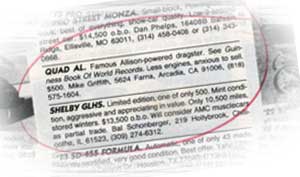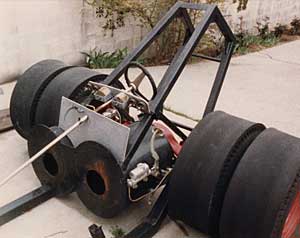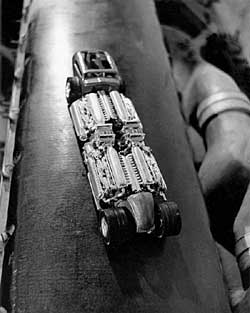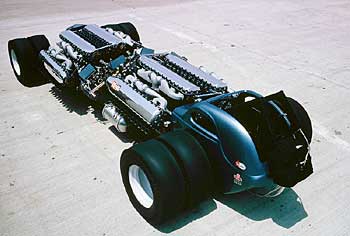
 The “Quad Al” Saga: Eight Slicks,
The “Quad Al” Saga: Eight Slicks,
Four-Wheel Drive, And One Murder
8/8/06
Behold the wildest Competition Coupe that you never saw run, and the most powerful piston car in history (as documented in the Guinness Book Of World Records, 1974-89 editions). In stock form, its quartet of WW II-vintage, Allison V12 aircraft engines collectively displaced 6840 cubic inches and produced 12,000 horsepower — an output that remains unchallenged by any piston vehicle, more than four decades later.
What was its builder thinking? We tracked that guy down to the Hawaiian island of Maui to ask a question that’s been raised by anyone who’s ever seen a photo of this 7000-pound, four-wheel-drive, eight-wheeled oddity.
“Well, I’d just sold the second Big Al [fiberglass ’34 Ford sedan] to Ray Alley,” recalled Jim Lytle, who turns 70 in September. “ I was looking for another Allison project. A buddy of mine, Ron Jolliffe, made a drawing of a coupe with side-by-side Allisons. It looked pretty cool. I said, ‘Ivo’s got four engines; why don’t we?’ So, I bought four AMT Allison kits and one of a stock Fiat, and built a model. The actual car turned out real close to that model, except I wound up tilting the rear engines 15 degrees, so their carburetors and throttle linkage would line up with the front engines.”
 Shown atop an Allison rocker cover, here's the custom-built model that convinced Lytle to create Quad Al. Starting with plastic models of four aircraft engines and a stock Fiat Topolino, he fabricated the rest. |
“The motors were the easy part,” he added. “In 1965, you could buy Allisons all day long for 50 to 150 bucks — and they made 3000 horsepower apiece, unmodified! I only had $2000 in that whole car, thanks to my sponsors. Cal Automotive gave me a ’glass body and grille shell; Moon donated the tanks; Champion came up with some special, unshrouded racing plugs that were developed for Allison hydros. All that was left to do was install clutches and gears.”
Alas, at this point, progress was suddenly stopped — by sticker shock: The lowest quote that Lytle could find for custom-built ring-and-pinion sets and clutch assemblies was $5000. “I was making 110 bucks a week as a design draftsman,” he explained. “Coming up with five grand for clutches and gears was out of the question.”
Instead, in late 1965, Jim reluctantly accepted an offer of $4000 for the car and trailer — which weighed 9000 pounds, combined. “It took eight guys to load that thing,” said Lytle. The buyer was a flamboyant movie stuntman, Tex Collins, who had previously purchased Cal Automotive, an early fiberglass manufacturer. He certainly had the means to finish Quad Al, plus a desire to drive it himself.
Before Tex could get it running, three unforeseen events intervened. First, Collins bought Big Al II from Alley (who had renamed the sedan P-51), giving him a race-ready Allison exhibition car (which Collins called Tex’s Twister.) Then Tex was shot to death. Finally, his widow sold off the dozen Allisons that he’d collected — including the four residing in Quad Al’s square-tube frame. Learning of this sale, Lytle abandoned his dream of seeing his creation on a drag strip.
 Amazingly, the chassis and body have survived the years and at least two additional owners. The current one met with Lytle last year in Indiana, where the car now resides, still sans engines. “This guy bought it with intentions of finishing it,” said Lytle, “but he can’t afford the engines; nobody can, anymore. The last one was built in 1947, and the airplane guys have scooped them all up. They’re getting 40 grand for a used, 60-year-old engine — and Quad Al needs four of those things.”
Amazingly, the chassis and body have survived the years and at least two additional owners. The current one met with Lytle last year in Indiana, where the car now resides, still sans engines. “This guy bought it with intentions of finishing it,” said Lytle, “but he can’t afford the engines; nobody can, anymore. The last one was built in 1947, and the airplane guys have scooped them all up. They’re getting 40 grand for a used, 60-year-old engine — and Quad Al needs four of those things.”
There’s a lot more to Jim Lytle’s lifelong love affair with what he calls “the engine that might’ve won World War II” — but no more space. Tune in next month for the stories behind his all-steel Big Al I and the revolutionary Big Al II, which carried drag racing’s first one-piece, lift-off, fiberglass body. ![]()
|
||
|
